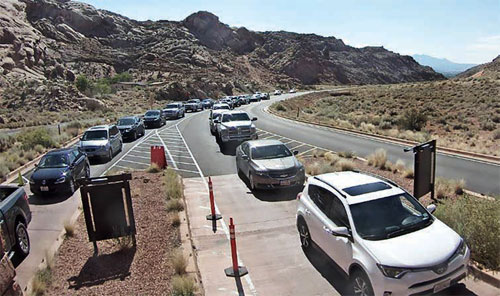By John Rogers
If Arches National Park moves forward with a plan to require advance reservations for visitors, it could lead to an initial economic hit of as much as $22 million to the Moab area, according to an economic analysis commissioned by the National Park Service (NPS) and authored by Robert Paterson, who works for Industrial Economics Inc. of Cambridge, Massachusetts.{mprestriction ids="1,3"}
The proposal, first advanced in 2016 by Kate Cannon, superintendent of the Southeast Utah Group of National Parks, would implement an advance reservation-based entry system during peak visitation from March through October. The plan, titled “Traffic Congestion Management Plan,” was presented to the Grand County Council.
The dollar figure that Paterson suggested is far from firm, the economist cautioned, and could be greatly reduced as people get used to whatever traffic management plan the park settles on. At the same time, however, such a reservation system “may enhance visitor experience and increase the economic value of trips to the national park,” said Paterson.
According to the NPS, Arches is one of a handful of national parks — others include Yellowstone, Yosemite, Acadia, Grand Canyon, Glacier and Utah’s Zion — that struggle at times during the year with overcrowding. Zion officials have been working on their own management plan for some time, and it, too, includes provisions for reservations, though they might not be included in the final proposal, according to a park official familiar with the discussion.
Overcrowding can lead to natural resource impacts. In Zion Canyon, for instance, where there are roughly 13 miles of official trails, visitors going off trail have created another 30 miles of unofficial “social” trails. Complicating the planning process at Zion are concerns over how a visitation cap would impact area businesses.
“I think people realize that there are crowding problems and would like to see some solutions to that,” Zion Superintendent Jeff Bradybaugh told the National Park Traveler magazine in December. “But there’s a great amount of concern that that could have negative economic impacts on the tourism industry. And we certainly are taking that into account and have those concerns as well.”
As with their counterparts at Zion, officials at Arches have been trying to figure out how to manage visitors and protect park resources and values for some time, Bradybaugh said. In November 2017, they released a draft plan that proposed reservations during peak visitation months. Such a plan is needed, they say, to address vehicle traffic and parking congestion problems that affect visitor access, visitor enjoyment and resource conditions, according to the magazine.
The Moab Sun Times reported that visitation to Arches National Park doubled in the past 11 years, reaching approximately 1.6 million visitors in 2017. “During the high-visitation season, March through October, visitors routinely wait in long lines to enter the park and then must search for empty parking spaces at all popular sites. Long lines to enter the park cause congestion at the intersection of U.S. 191 and the park entrance road, which can be a serious traffic hazard,” the newspaper said.
The reservation proposal is viewed as a way to give visitors certainty of entry, reduce or eliminate long entrance lines, spread visitation more evenly across the day and improve the visitor experience by ensuring available parking space.
But Paterson pointed to some uncertainties in reaching his conclusions over the economic impact such a plan would create.
“Representatives from the International Inbound Travel Association board have suggested that regardless of whether a system is implemented next year or not, there will likely be a reduction in foreign bus tours booked due to concerns about the system,” Paterson said in his report sent to the park several months ago. The report was just recently publicly acknowledged by park officials when they announced plans for a public meeting this summer about the progress being made on the management plan. Paterson is expected to be at the meeting.
Paterson admitted that his work so far could not predict the long-term impact to the area’s economy. He based his estimate on other national parks that used various approaches to deal with congestion.
“While they are all qualitatively different circumstances ... they may be similar in an economic sense in that they created uncertainty that in turn affected visitation,” Paterson wrote. “Based on these analyses, relevant literature and professional judgment, it is my opinion that visitation to Arches may be reduced by 5 to 10 percent of what it otherwise would be during the first year that a system is implemented. Relying on NPS estimates of Arches visitor spending, this could result in a reduction in spending of $11 million to $22 million relative to what otherwise would be predicted in that first year, which in turn could reduce overall output, employment, wages and tax receipts through associated multipliers.”
Paterson again qualified his analysis, concluding that once visitors adapted to the system, “visitation could revert to what it would otherwise be [without] the system by Year 3.”{/mprestriction}








